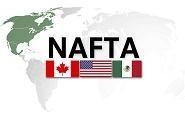Trade Cases

Last-Minute Talks Yield New NAFTA--USMCA
Written by Sandy Williams
October 2, 2018
After months of contentious bargaining, the U.S. has reached a new trilateral trade agreement with Canada and Mexico to replace NAFTA. In last minute negotiations, Canada agreed to give the U.S. increased dairy market access while retaining the Chapter 19 trade remedy dispute settlement.
The new treaty, to be called the U.S.-Mexico-Canada Agreement (USMCA), will require approval by the U.S. Congress, but has met the deadline to allow outgoing Mexican President Enrique Peña Nieto to sign it before leaving office on Dec. 1.
The dairy concession gives U.S dairy farmers access to approximately 3.5 percent of the Canadian dairy market and eliminates the competitive dairy classes.
Steel and aluminum tariffs under Section 232 are not covered by the new agreement, but an accommodation was added to protect Canada and Mexico from potential U.S. Section 232 auto tariffs.
The accommodation allows Canada and Mexico to have 2.6 million autos excluded from any potential tariffs on vehicles imported into the United States. Currently, Canada exports about 2 million and Mexico 1.8 million vehicles to the United States annually. Additionally, any measure imposed by the United States must give Canada and Mexico a 60-day window for negotiations.
Automotive rules of origin will require that beginning in 2020 cars and trucks imported to North America must have 75 percent of their components manufactured in the U.S, Canada or Mexico to avoid tariffs, up from 62.5 percent North American content. In addition, 30 percent of a vehicle’s production must be performed by workers earning at least $16 per hour. The percentage will move to 40 percent in 2023.
A sunset provision agreed to by the U.S. and Mexico in August is included in the USMCA deal. The agreement will be reviewed by the three nations every six years with the option to extend it for an additional 16 years.
“We’ve also included the review and termination provision that we previously announced in our deal with Mexico, which will ensure that we never end up in this position again with an agreement that is stale and outdated and unbalanced in a way that is not beneficial to the United States,” said a U.S. official as reported by Inside US Trade.
The new agreement also contains specific language for the first time on currency manipulation and monetary misalignment practices.
Article 33.4 states: “Each Party confirms that it is bound under the Articles of Agreement of the IMF to avoid manipulating exchange rates or the international monetary system in order to prevent effective balance of payments adjustment or to gain an unfair competitive advantage.”
The Article further states that each party should:
- achieve and maintain a market-determined exchange rate regime;
- refrain from competitive devaluation, including through intervention in the foreign exchange market; and
- strengthen underlying economic fundamentals, which reinforces the conditions for macroeconomic and exchange rate stability.
President Trump called the renegotiated NAFTA deal “truly historic news for our nation and indeed for the world.”
“It’s my great honor to announce that we have successfully completed negotiations on a brand new deal to terminate and replace NAFTA,” Trump said in a press conference from the Rose Garden on Tuesday. “I have long contended that NAFTA was perhaps the worst trade deal ever made.
“I plan to sign the agreement by the end of November. I then will submit it for approval to Congress where in theory there should be no trouble — but anything you submit to Congress is trouble, no matter what,” Trump said.
Trump said tariffs were an important part of the negotiating process. “Just for the babies out there that talk about tariffs—that includes Congress, ‘please don’t charge tariffs.’ Without tariffs, we wouldn’t be standing here,” he added.
Trump remained optimistic regarding passage of USMCA. “If it doesn’t, we have lots of other alternatives,” he said without detailing specifics. “Republicans love it. Industry loves it. If it’s fair, it will pass. I think it will pass easily.”

Sandy Williams
Read more from Sandy WilliamsLatest in Trade Cases

SMU Survey: Less support seen for Trump tariff policies
Meanwhile, an increasing number think it's too early to say whether the penalties are going to bring more manufacturing to the US.

CRU: USW seeks exclusion for Canada from Trump’s tariffs
The union is also urging stronger enforcement against countries such as China which break trade rules, and a coordinated Canada-US strategy to protect union jobs across the North America

Price on trade: A lot happened last week – and it wasn’t all about tariffs
Should foreign investment be allowed to reshape the American steel Industry? Not to be lost in the recent on-again-off-again tariff frenzy, Nippon Steel’s proposed takeover of U.S. Steel has also found itself in President Trump’s crosshairs when it comes to trade and industrial policy. Nippon Steel initially announced its nearly $15-billion bid for U.S. Steel […]

Trump signs executive order aimed at making US shipbuilding ‘great again’
President Trump on Wednesday signed an executive order meant to breathe new life into American shipbuilding and curb Chinese dominance in the sector.

Trump still against selling USS to Japanese firm: Report
Despite ordering a new review of Nippon Steel’s bid for U.S. Steel, President Trump said he is still against selling USS to a Japanese company, according to media reports.
